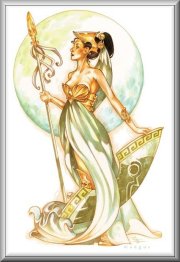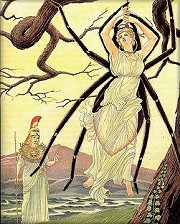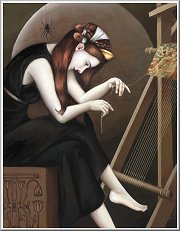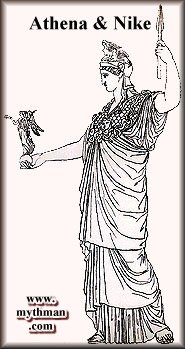
ATHENA
CLICK TO ENLARGE

ATHENA
CLICK TO ENLARGE

ATHENA & ARACHNE
CLICK TO ENLARGE

ATHENA & NIKE

ATHENA
by BlackWolf Studio
CLICK TO ENLARGE
|
ATHENA PAGE THREE
continued from page two
Athena's favorite companion when she was a child was a
girl called Pallas, and the two were inseparable, honing their
fighting skills and sharing good times. Pallas was the daughter
of the river god Triton.
One time, during a practice sparring session, Athena
accidentally mortally wounded her best friend. Grieving sorely
for her death, Athena made a wooden image in her likeness, which
was called the Palladium. She also took on her name as part of
hers and henceforth was often referred to as Pallas Athena.
One of the few times that Athena showed petulance was in her
weaving contest against the mortal named Arachne. This young
woman fancied herself the world's best weaver, in her arrogance
even daring to compare herself favorably against Athena.
Hearing this impudence, Athena took on the guise of an old woman
and appeared at Arachne's house to give her some friendly advice
to respect the all-powerful gods.
Arachne was too vain to listen and told the "old woman" to be
gone. "Let the great Athena try her skill against mine, and
if I lose she can do whatever she pleases with me," she
boasted.
The great goddess of wisdom, arts and crafts and war had heard
enough! That's when Athena dropped her disguise and revealed her
true identity. All the bystanders, who had gathered to marvel at
the dexterity of Arachne's divine weaving, fell to their knees
in reverence and awe, except for Arachne, who in her conceit
remained unmoved.
Game on! The two began their weaving contest, and for a while
Arachne held her own against Athena, even sarcastically poking
fun at the gods through the tapestry she crafted --
Arachne took the foibles and mistakes of the Olympians and
ridiculed them in her art.
Finally Athena had enough, realizing that this foolish woman was
far too self-absorbed to be capable of rehabilitation. The
goddess simply touched the impudent mortal on the forehead,
making her feel the shame she had brought upon herself.
Aghast at the realization of her blinding egotism, Arachne ran
off and hung herself from a tree.
Feeling sorry for the hanging Arachne, Athena brought her back
to life, but so that mortals learn that it doesn't pay to
compare themselves to the gods, she changed Arachne into a
spider.
There she sits, Arachne and her descendents, forever weaving
their web, testament to the folly of vanity.
Athena’s special city was Athens, patronage of which she won
from Poseidon by giving the city the olive tree which King
Cecrops judged to be a better gift than the water spring that
Poseidon provided.
Both gods wanted Athens as their own, and Poseidon struck the
side of the mountain with his trident, causing a salt spring to
burst forth.
Wise Athena in turn created the olive tree, which provided
people with food, oil and wood for their fires. Needless to say,
her gift was far superior, and she was awarded Athens, which was
named in her honor.
Athena's tree is the olive and her bird is the owl, also a
symbol of wisdom. Other symbols of this awesome goddess are the
fearsome Aegis, her helmet, shield and spear, and she is often
pictured holding Nike, the goddess of Victory, or an owl,
signifying her wisdom.
Athena was frequently represented in works of art, with the
pinnacle being the three statues by the great sculptor Pheidias:
 The first
was the celebrated colossal statue of the goddess, of gold and
ivory, which was erected on the acropolis of Athens; This statue
represented the goddess in a standing position, bearing in her
hand a Nike four cubits in height. The shield stood by her feet;
her robe came down to her feet, on her breast was the head
of Medusa, in her right hand she bore a lance, and at her feet
there lay a serpent. The first
was the celebrated colossal statue of the goddess, of gold and
ivory, which was erected on the acropolis of Athens; This statue
represented the goddess in a standing position, bearing in her
hand a Nike four cubits in height. The shield stood by her feet;
her robe came down to her feet, on her breast was the head
of Medusa, in her right hand she bore a lance, and at her feet
there lay a serpent.
 The second
was a still greater bronze statue, made out of the spoils taken
by the Athenians in the battle of Marathon; The second
was a still greater bronze statue, made out of the spoils taken
by the Athenians in the battle of Marathon;
 The third
was a small bronze statue called the beautiful or the
Lemnian Athena, because it had been dedicated at Athens
by the Lemnian islanders. The third
was a small bronze statue called the beautiful or the
Lemnian Athena, because it had been dedicated at Athens
by the Lemnian islanders.
A great number of statues, busts, reliefs, coins and vase
paintings of Athena still exist today. The attributes which
characterize the goddess in these ancient works of art are:
 The
helmet, which she usually wears on her head, but in a few
instances carries in her hand. It is usually ornamented in the
most beautiful manner, decorated with griffins, heads of rams,
horses, and sphinxes. The
helmet, which she usually wears on her head, but in a few
instances carries in her hand. It is usually ornamented in the
most beautiful manner, decorated with griffins, heads of rams,
horses, and sphinxes.
 The
aegis, the protective armor of Zeus, which he permitted her
alone to utilize; The
aegis, the protective armor of Zeus, which he permitted her
alone to utilize;
 The
round Argolic shield, in the centre of which is represented the
head of Medusa. The
round Argolic shield, in the centre of which is represented the
head of Medusa.
 Objects
sacred to her, such as an olive branch, a serpent, an owl, a
rooster, and a spear. Her garment is usually the Spartan tunic
without sleeves, and over it she wears a cloak called the
peplus, or, though rarely, the one called the chlamys. Objects
sacred to her, such as an olive branch, a serpent, an owl, a
rooster, and a spear. Her garment is usually the Spartan tunic
without sleeves, and over it she wears a cloak called the
peplus, or, though rarely, the one called the chlamys.
The general expression of her figure is thoughtfulness and
earnestness; her face is rather oval than round, the hair is
rich and generally combed backwards over the temples, and floats
freely down behind.
The whole figure is majestic, and rather strong built than
slender: the hips are small and the shoulders broad, so that the
whole somewhat resembles a male figure.
ATHENA CONTINUES ON PAGE
FOUR
LOTS MORE STORIES AND A TON OF PIX
CLICK HERE!

[home][page
one][page two][page
three][page four][page
five]
|







